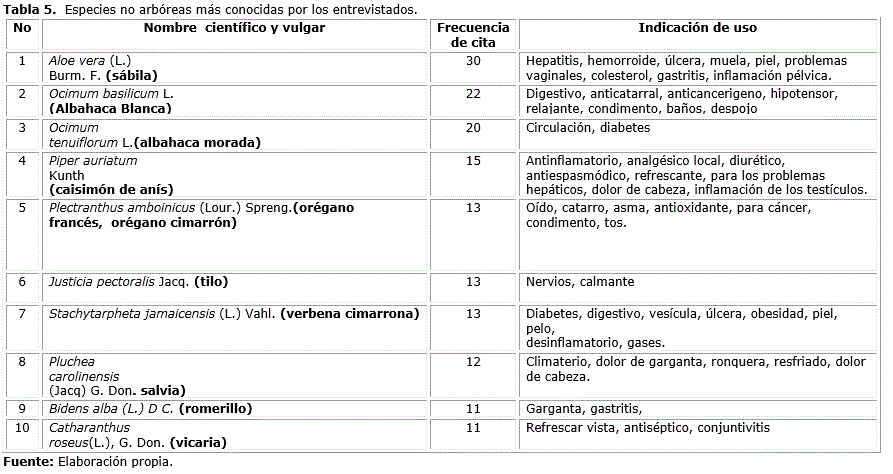Etnobotánica: empleo de plantas para uso medicinal
Contenido principal del artículo
Resumen
Descargas
Detalles del artículo
Citas
ACOSTA, I. Estudio de los extractos del follaje de Bursera simaruba Sargent (almácigo). Tesis de maestría inédita, Universidad de La Habana, 2007.
AGUIAR M. y García, J. L. Integración de la mujer a las labores agrícolas en San Miguel del Padrón. En: IX Encuentro Provincial de Agricultores Urbanos y Suburbanos «Por un desarrollo Agrario y sostenido». Asociación Cubana de Técnicos Agrícolas y Forestales, La Habana, 2012 p. 71-72.
ARENCIBIA, R. Un científico popular. Ciudad Habana: Colección Ideas, 2008.
BISSE, J. Árboles de Cuba. Ciudad de La Habana: Científico-Técnico, 1988.
COLECTIVO DE AUTORES. Adaptación, Manejo y uso del genero Eucalyptus en Cuba. Instituto de Investigaciones Agro-Forestales, La Habana. 2011, ISBN: 978-969-7215-07-3
COLECTIVO DE AUTORES. Bosques de Cuba. La Habana: Editorial Científico Técnica, 2011, ISBN 978-959-05-0641-3.
DUBOIS, J.C.L. Utilización de productos forestales madereros y no madereros por los habitantes de los bosques amazónicos. Unasylva, 1996, 186(47), 8-14, ISSN 0251- 584
FARIÑAS. Salud con tradición. La medicina natural y tradicional constituye una alternativa complementaria a disposición de la población en cada comunidad. Periódico Granma, Cuba, 2014.
GIL, R. y CARMONA, J. Veintitrés especies botánicas con potencialidad terapéutica. Revista de la Facultad de Farmacia de la Universidad de Los Andes, 2001, 42, 37-39.
HERNÁNDEZ, J.E, y C. MUÒOZ. Biodiversidad y recursos filogenéticos en Andalucía. En: J.E. HERNÁNDEZ. Protección de la Flora en Andalucía,Sevilla, España. 1994, p. 15-20.
HUNN, S. The Value of Subsistence for the Future of the World. En: V.D. NAZAREA, Ethnoecology. Situated knowledge. Tucson, Arizona, 1999, 23-36 p.
LESLIE, A. SARRE; M. S. FILHO y A. BUANG. La certificación forestal y la Biodiversidad. Revista Actualidad Forestal Tropical, 2002, 10(3), 13-15.
MONTALVO, J.M. Consulta personal. Instituto de Investigaciones Agro-Forestales, 2009.
MURILLO, J. Metodología de la Investigación avanzada .Consultado 15 de septiembre del 2013. Disponible en http//:www.Van.es/personal-pdi/stmaria/J.murillo …/entrevista-(trabajo pdf).
PARDO, M. y E. GÓMEZ. Etnobotánica: aprovechamiento tradicional de plantas y patrimonio cultural. Jardín Botánico Madrid. Anales, 2003, 60(1), 171-182.
PARDO, M. y R. MORALES. Patrimonio. natural, usos tradicionales y conservación. Quercus, 2001,189, 64-65.
REMMERS, G.G.A. Endogenous development in traditional rural areas: hitting a moving target. En: IV International Seminar CERES/CAMAR. Towards regional plans for endogenous rural development in Europe, ISEC. Córdoba.1994, p. 12-14.
ROIG, J. T. Diccionario Botánico de Nombres Vulgares Cubanos, tomo 1 y 2, La Habana: Editorial Científico-Técnica, Colección Diccionario, 1953.
ROIG, J. T. Plantas medicinales, aromáticas o venenosas de Cuba. Tomo I y II. 2ª ed. La Habana: Editorial Científico Técnica. Instituto Cubano del Libro, 2012. 978-959-05-0663-5 y 978-959-05-0664-2.
VELAZQUEZ, D. et al. Xiloteca de Maderas cubanas «Julián Acuña». Manual de Xiloteca, Instituto de Investigaciones Agro-Forestales, La Habana, 2012, ISBN: 978-959-7215-09-7.
VILLAVICENCIO, R. Producción de plantas medicinales por la técnica de permacultura. En: IX Encuentro Provincial de Agricultores Urbanos y Suburbanos «Por un desarrollo Agrario y sostenido» La Habana: Asociación Cubana de Técnicos Agrícolas y Forestales, 2012 p. 33.


